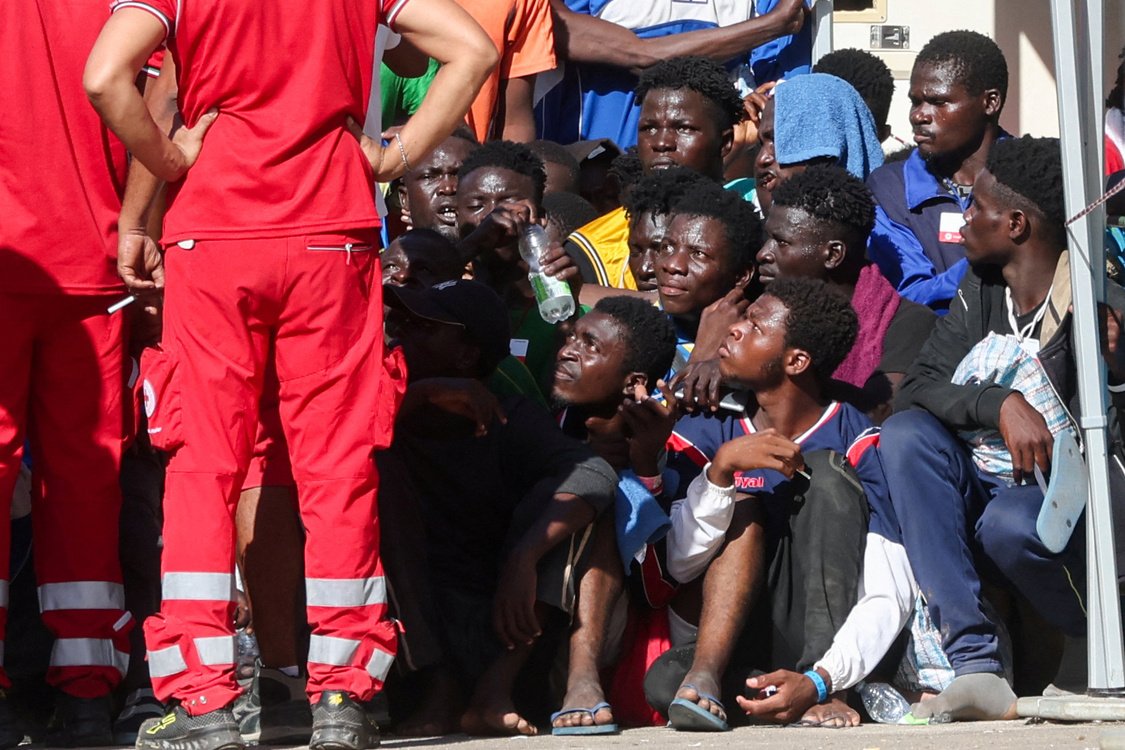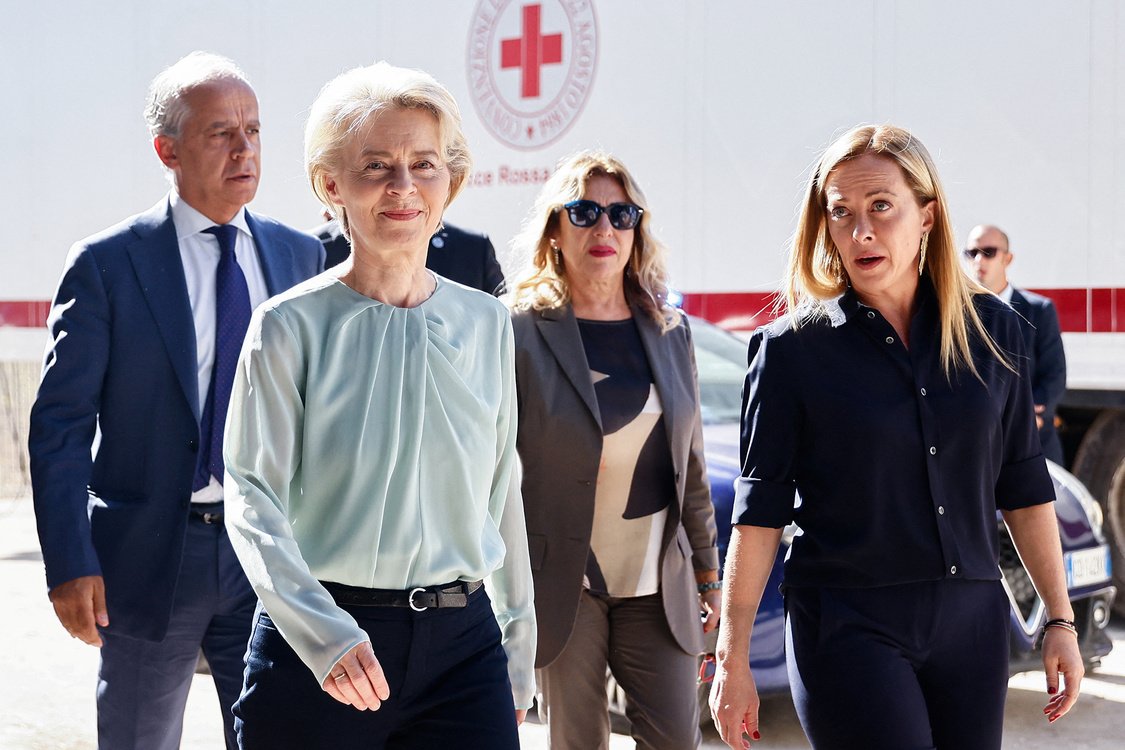Europe’s Migration Dilemma
Hundreds of thousands of migrants made the dangerous journey to Europe in 2023, fleeing war, poverty, and natural disasters. The increase in arrivals has fueled support for far-right political parties.
The long and often arduous journey to Europe has not been a dealbreaker for the hundreds of thousands of migrants who have arrived on the continent illegally in recent years. More than 385,000 such migrants entered Europe in 2023, nearly triple the pandemic-era low in 2020. These were just a fraction of the twenty-nine million immigrants who arrived in the past decade, legally and illegally, placing significant strain on a migration system already considered ineffectual.

Migrants endure voyages on unseaworthy vessels, travel on foot through war zones or scalding deserts, and encounter predatory human smugglers or hostile locals. Last year alone, more than three thousand migrants died crossing the Mediterranean Sea to reach Europe.
But disembarking in Europe presents new hurdles. Politicians have pledged to crack down on what they call a migration crisis, especially those from far-right parties, which are gaining support ahead of European Parliament elections in June. Meanwhile, European Union (EU) countries are grappling with how to balance stronger border enforcement with concerns over human rights and migrant safety.
Fleeing Conflict, Repression, and Poverty
While the vast majority of migrants to Europe arrive legally, the continent has seen a steady increase in irregular immigration, in which migrants arrive in Europe without legal permission.
Recent migration surges have often been driven by the disruptions caused by conflict. In 2015, the main cause was fighting and persecution in Afghanistan and Syria. More recently, Russia’s war in Ukraine has fueled a surge in immigration to Europe, including from African and Middle Eastern countries that rely on trade with Ukraine. Indeed, migration experts say a global rise in conflict over the last decade has caused the number of displaced people across the world to almost double [PDF], reaching 114 million people in 2023.
Other push factors include the COVID-19 pandemic and its economic fallout, a string of coups in the Sahel, humanitarian crises in countries such as Afghanistan, and natural disasters exacerbated by climate change.
Europe is also a magnet for migrants seeking better economic opportunities, reunion with family members, or access to greater protections for refugees and asylum seekers under EU and international law. Economic migrants can be a source of friction with locals, particularly as the EU weathers its own economic downturn, with record inflation and more than twenty-seven million people underemployed or unemployed this spring. The European Commission notes that most refugees from Africa and Asia will remain in neighboring countries rather than traveling on to Europe.
In 2023, Europe received the most irregular migrants from Syria, which has yet to recover from more than a decade of war that has displaced half of its population. The next largest groups were Guineans and Senegalese fleeing economic struggles and political instability in those West African countries, followed by Afghans escaping Taliban rule.
Migration Pathways and Dangers
Many migrants now favor a route through the Central Mediterranean, in contrast with 2015, when most arrived via the Eastern Mediterranean from Turkey. More than 157,000 people traveled the central route from North Africa to Italy or Malta in 2023, according to EU border agency Frontex.

While there are departure points all along the North African coast, many emigrants have converged on the port city of Sfax, Tunisia, as their launch point. This offers a shorter trip—117 miles (188 kilometers)—compared to departures from Algeria, Egypt, Libya, and Morocco, and access to a sophisticated, but illicit, migration economy that Tunisia’s security forces have struggled to control. Those smuggling networks help migrants avoid immigration authorities, but they also often expose them to extortion, trafficking, and sexual violence.
Getting to Sfax is a journey in itself, often involving high costs and traversing dangerous conflict zones in sub-Saharan Africa. Once there, migrants often face a hostile reception: Tunisia’s economy is struggling, and President Kais Saied, the authoritarian leader of the mostly Arab country, has stoked public vitriol against Black sub-Saharan Africans in particular. Along with the risk of expulsion, many migrants report being detained in inhumane facilities, assaulted by security forces, and forcibly transferred to Tunisia’s remote desert borders with Algeria and Libya.

Migrants often depart from Sfax in ships crowded with as many passengers as possible—the voyage can cost $800 per person or more—or in barely seaworthy small boats. High-fatality shipwrecks are common, such as the June 2023 sinking of the Adriana, in which more than six hundred men, women, and children drowned.
More than 29,500 migrants have died crossing the Mediterranean since 2014, according to the UN International Organization for Migration’s Missing Migrants Project. In some instances, border authorities and nongovernmental organizations are able to reach ships in distress, with Frontex helping to rescue forty-three thousand people at sea in 2023.
The dangers of the passage are well known, but many migrants say it is worth the risk. After the nonprofit SOS Méditerranée saved a Nigerian woman identified as “Ada” at sea in January 2023, the twenty-year-old told her rescuers, “I knew this boat was dangerous to go onto, but what other choice did I have left?”
Europe’s Crowded ‘Gateway’
The most popular entry to the continent is Italy’s southernmost point, the island of Lampedusa, which has earned the nickname the “gateway to Europe.” A smaller number of migrants head to Malta or Greece.


Migrants are first processed by authorities at Lampedusa’s immigrant reception center, one of four such hot spots in Italy. There, they are fingerprinted and photographed, given health screenings and medical care, and informed about their immigration options.

Given the massive influx of migrants to the island—which at one point received around seven thousand people in just two days—its facilities are consistently crowded well beyond maximum capacity. To ease the burden, thousands of migrants are sent to Sicily or mainland Italy for processing, where opposition lawmakers and human rights groups say they often receive poor treatment. Many of those who remain in Lampedusa likewise struggle to fulfill their basic needs, and migrants often take to the streets in search of food, water, and a place to sleep.

“These are people that come with a lot of trauma,” said Susanna Zanfrini, director of the International Rescue Committee in Italy. “When they arrive, they are really in need of specialized support and care. And this is unfortunately not always the case.”
Most migrants end up applying for asylum, which requires proving they are fleeing harm or persecution, or the fear of persecution, in their home country. The process allows them to remain in Italy for up to six months and, if successful, asylees can enjoy a host of benefits, including the right to education, work, travel, and eventually, citizenship. In theory, a failed asylum application means deportation, but in practice, many migrants are not welcome back in their home countries and stay in the EU in legal limbo.
‘Costly and Cruel’ or Not Strict Enough?
As migration rises, European politics has become increasingly embroiled in the issue. Some EU policymakers call it a security crisis and press for stronger border enforcement, while others are wary of further limiting safe migration options.
A major point of contention is the suite of deals that the bloc has made with non-EU countries, beginning with Turkey and expanding to include Egypt, Lebanon, Mauritania, and Tunisia, to help block migration in exchange for financial aid. Italy and the United Kingdom have also signed their own migration deals with third countries, including Albania and Rwanda, to intercept migrants at sea and accelerate deportation efforts.

After years of debate, the European Parliament, led by a coalition of center-left and center-right parties, passed a sweeping migration policy deal in April 2024 that it hopes will address the system’s shortcomings. Front-line countries such as Greece, Italy, and Spain have long complained that they are unfairly burdened by the EU’s Dublin Regulation, which requires migrants to apply for asylum in the first country in which they arrived. The pact now requires other EU states to share some of those responsibilities; it also toughens border screening procedures and facilitates more rapid deportation.


But the deal has many critics: Parliament’s left-wing parties said it was too harsh, while many conservatives argue that it does not go far enough. Some experts say the new rules do little to resolve complaints about the Dublin Regulation. Human rights and migrant advocacy groups decry the pact in even stronger terms, with more than fifty of them signing a letter opposing what they call the “ill-functioning, costly, and cruel” measures. Rights groups have called instead for strengthening migrant protections and improving access to safe migration pathways.
The reforms are meant to blunt support for the far-right, though some migrant advocates say they could boost it instead. Claudia Bonamini, the policy and advocacy coordinator for Jesuit Refugee Service Europe, says established attitudes of racism and Islamophobia have bolstered far-right parties’ exclusionary rhetoric. “There is latent racism in Europe that also comes from a history of colonialism,” she says. “It’s very easy for some political forces to use this and leverage on the fear.”

What comes next for the bloc’s migration policy could depend on the outcome of the June parliamentary elections. Far-right, anti-immigrant parties such as the Sweden Democrats, the Alternative for Germany, and France’s National Rally continue their rise as recent polling [PDF] shows immigration is one of the top five issues of concern for Europeans. Analysts say those right-ring groupings are poised to catapult to significant influence in the European Parliament, as many already have at the national level in countries such as Austria, Belgium, and the Netherlands.
That could mean major shifts for EU policy, especially on immigration. Many right-wing parties propose making it more difficult to enter the continent and are reportedly discussing plans for mass deportations. Whether that happens will likely depend on if they can successfully cooperate with the center-right parties, many of which have refused to work with them in the past.

Recommended Resources
CFR’s World101 library breaks down the difference between asylum seekers, immigrants, and refugees.
CNN visualizes Europe’s 2015–16 migrant crisis.
The UN International Organization for Migration’s Missing Migrants Project documents migrant deaths in the Mediterranean Sea.
This 2024 report [PDF] by the charity Doctors Without Borders details the human costs of the EU’s migration policies.
For Think Global Health, CFR’s Abi McGowan explores the deadly path migrants take to get to Europe’s shores.
This CFR Infoguide examines the global migrant crisis and the strains it places on the international refugee system.
 Online Store
Online Store




